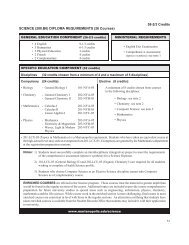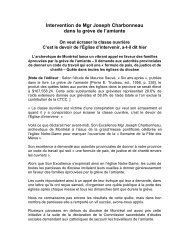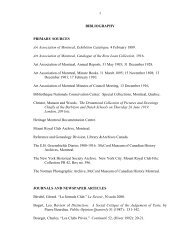The Back to Work Settlements between the Asbestos ... - Marianopolis
The Back to Work Settlements between the Asbestos ... - Marianopolis
The Back to Work Settlements between the Asbestos ... - Marianopolis
Create successful ePaper yourself
Turn your PDF publications into a flip-book with our unique Google optimized e-Paper software.
<strong>The</strong> <strong>Back</strong> <strong>to</strong> <strong>Work</strong> <strong>Settlements</strong> <strong>between</strong> <strong>the</strong> Asbes<strong>to</strong>s<strong>Work</strong>ers and <strong>the</strong> Various CompaniesClaude Bélanger,Department of His<strong>to</strong>ry,<strong>Marianopolis</strong> College.Essentially, <strong>the</strong>re were two main separate settlements <strong>to</strong> end <strong>the</strong> Asbes<strong>to</strong>sstrike. A first group of workers representing about half of those on strike,mainly workers from <strong>The</strong>tford-Mines — those of <strong>the</strong> Quebec Asbes<strong>to</strong>sCorporation, Johnson Mines Limited and <strong>the</strong> Flintkote Mines — accepted<strong>the</strong> terms of <strong>the</strong> companies at a union meeting on June 23, 1949. <strong>The</strong>second group, representing <strong>the</strong> workers of <strong>the</strong> Johns-Manville Corporation,from Asbes<strong>to</strong>s, settled on July 1, 1949, following <strong>the</strong> mediation ofArchbishop Maurice Roy of Quebec City. At <strong>the</strong> time when <strong>the</strong> workerssettled with <strong>the</strong> companies, <strong>the</strong> asbes<strong>to</strong>s strike was reported <strong>to</strong> have been<strong>the</strong> longest strike in Quebec his<strong>to</strong>ry.Settlement with Quebec Asbes<strong>to</strong>s Corporation, Johnson MinesLimited and Flintkote Mines:<strong>The</strong> settlement provided that <strong>the</strong> dispute would be submitted <strong>to</strong> a board ofarbitration should negotiations <strong>between</strong> <strong>the</strong> union and <strong>the</strong> companies fail in<strong>the</strong> next ten days. Essentially, <strong>the</strong> union accepted <strong>to</strong> abide by <strong>the</strong> ProvincialLabor Relations Act.Fur<strong>the</strong>r, <strong>the</strong> agreement provided for <strong>the</strong> following four points:1. <strong>The</strong> strikers would return <strong>to</strong> work on Monday, June 27, 1949.2. <strong>The</strong> companies agreed <strong>to</strong> recommend <strong>to</strong> <strong>the</strong> Quebec’s Labour Board<strong>the</strong> recertification of <strong>the</strong> union. Thus, <strong>the</strong> union would be legallyrecognised as <strong>the</strong> legitimate (legal) bargaining partner with <strong>the</strong>companies.3. Strikers sentenced by <strong>the</strong> courts on charges brought against <strong>the</strong>m forviolence committed during <strong>the</strong> strike would not be rehired unless <strong>the</strong>companies consented. It seemed clear at <strong>the</strong> time that <strong>the</strong>companies did not intend <strong>to</strong> rehire workers condemned for <strong>the</strong> attackon mine superintendent, Lionel Piuze, and those involved in <strong>the</strong>attempted dynamiting of <strong>the</strong> residences of Andrew Johnson and A.Penhale, both mine presidents.
5. As <strong>the</strong> men returned <strong>to</strong> work, <strong>the</strong> company would undertake <strong>to</strong>reemploy at <strong>the</strong> mine, mill and fac<strong>to</strong>ry, as many of <strong>the</strong> workers aspossible, keeping in mind efficient working conditions, until normals<strong>to</strong>cks of asbes<strong>to</strong>s would be res<strong>to</strong>red.6. Fur<strong>the</strong>rmore, <strong>the</strong> company would attempt <strong>to</strong> increase undergroundoperations by around 100 employees.7. Direct negotiations would begin immediately. Should <strong>the</strong>se fail, bothparties agreed that Judge Thomas Tremblay would act as chairmanof <strong>the</strong> arbitration board.8. When <strong>the</strong> new agreement would be signed, <strong>the</strong> Minister of Labor willattempt <strong>to</strong> bring about an amicable settlement of <strong>the</strong> civil actionsbrought by both sides before <strong>the</strong> courts. Note that this addressesonly civil actions and does not apply <strong>to</strong> criminal charges.9. Industrial security would be a subject of discussion with <strong>the</strong> Ministerof Labor.10. <strong>The</strong> Union recognized <strong>the</strong> rights of ownership and management of<strong>the</strong> company. It agreed <strong>to</strong> incorporate in<strong>to</strong> <strong>the</strong> contract amanagement’s clause. This had always been an important point with<strong>the</strong> Johns-Manville Company. This aspect of <strong>the</strong> strike has beenextensively studied by his<strong>to</strong>rian Jacques Rouillard in his article inLabour (Fall 2000).11. Upon <strong>the</strong>ir return <strong>to</strong> work, <strong>the</strong> workers will be paid at <strong>the</strong> current rate.This rate was 10¢ an hour more than when <strong>the</strong> strike was declared.© 2001 Claude Bélanger, <strong>Marianopolis</strong> College
















